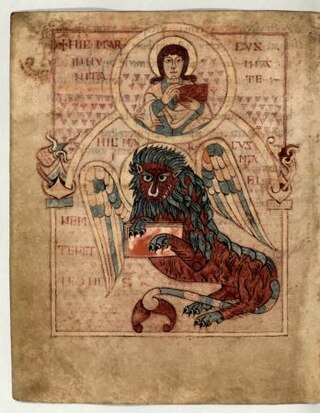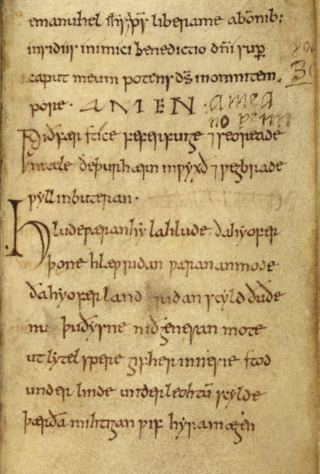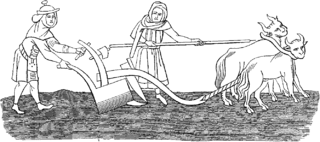
The Book of Cerne is an early ninth-century Insular or Anglo-Saxon Latin personal prayer book with Old English components. It belongs to a group of four such early prayer books, the others being the Royal Prayerbook, the Harleian prayerbook, and the Book of Nunnaminster. It is now commonly believed to have been produced sometime between ca. 820 and 840 AD in the Southumbrian/Mercian region of England. The original book contains a collection of several different texts, including New Testament Gospel excerpts, a selection of prayers and hymns with a version of the Lorica of Laidcenn, an abbreviated or Breviate Psalter, and a text of the Harrowing of Hell liturgical drama, which were combined to provide a source used for private devotion and contemplation. Based on stylistic and palaeographical features, the Book of Cerne has been included within the Canterbury or Tiberius group of manuscripts that were manufactured in southern England in the 8th and 9th centuries AD associated with the Mercian hegemony in Anglo-Saxon England. This Anglo-Saxon manuscript is considered to be the most sophisticated and elaborate of this group. The Book of Cerne exhibits various Irish/Celtic, Anglo-Saxon, Continental, and Mediterranean influences in its texts, ornamentation, and embellishment.
The Old English Bible translations are the partial translations of the Bible prepared in medieval England into the Old English language. The translations are from Latin texts, not the original languages.

"Wið fǣrstice" is an Old English medical text surviving in the collection known now as Lacnunga in the British Library. Wið fǣrstiċe means 'against a sudden/violent stabbing pain'; and according to Felix Grendon, whose collection of Anglo-Saxon charms appeared in the Journal of American Folklore in 1908, “the charm is intended to cure a sudden twinge or stitch, possibly rheumatism that can be due to being shot by witches, elves, and other spirits that fly through the air.” Scholars have often sought to identify this as rheumatism, but other possibilities should not be excluded. The remedy describes how to make a salve, but its main interest lies in the unique charm which follows. This describes how the færstice has been caused by the projectiles of 'mighty women', whom the healer will combat. The charm also mentions elves, believed responsible for elfshot, and provides the only attestation outside personal names of the Old English form of the name of the old Germanic gods, known as the Æsir in Norse mythology.

Pseudo-Apuleius is the name given in modern scholarship to the author of a 4th-century herbal known as Pseudo-Apuleius Herbarius or Herbarium Apuleii Platonici. The author of the text apparently wished readers to think that it was by Apuleius of Madaura (124–170 CE), the Roman poet and philosopher, but modern scholars do not believe this attribution. Little or nothing else is known of Pseudo-Apuleius.
Saint Eormenhild is a 7th-century Anglo-Saxon saint venerated in the Eastern Orthodox and Roman Catholic churches.

Bald's Leechbook is a medical text in Old English and Medieval Latin probably compiled in the mid-tenth century, possibly under the influence of Alfred the Great's educational reforms.
The Nine Herbs Charm, Nigon Wyrta Galdor, Lay of the Nine Healing Herbs, or Nine Wort Spell is an Old English charm recorded in the tenth-century CE. Anglo-Saxon medical compilation known as Lacnunga, which survives on the manuscript, Harley MS 585, in the British Library, in London. The charm involves the preparation of nine plants.
The Æcerbot is an Anglo-Saxon metrical charm recorded in the 11th century, intended to remedy fields that yielded poorly.
Anglo-Saxon metrical charms were sets of instructions generally written to magically resolve a situation or disease. Usually, these charms involve some sort of physical action, including making a medical potion, repeating a certain set of words, or writing a specific set of words on an object. These Anglo-Saxon charms tell a great deal about medieval medical theory and practice. Although most medical texts found from the pre-Christian Anglo-Saxon period are translations of Classical texts in Latin, these charms were originally written in Old English.
Magic in Anglo-Saxon England refers to the belief and practice of magic by the Anglo-Saxons between the fifth and eleventh centuries AD in Early Mediaeval England. In this period, magical practices were used for a variety of reasons, but from the available evidence it appears that they were predominantly used for healing ailments and creating amulets, although it is apparent that at times they were also used to curse.
"Against a Wen" is an Old English metrical charm and medical text found in the London, British Library, Royal MS. 4A.XIV. It appears to describe a remedy for ridding oneself of a wen, which is an Old English term for a cyst or skin blemish. The charm is addressed to the wen itself, asking it to leave. The charm prescribes methods for curing the blemish, and describes it as it gradually shrinks until it disappears.
On the Resting-Places of the Saints is a heading given to two early medieval pieces of writing, also known as Þá hálgan and the Secgan, which exist in various manuscript forms in both Old English and Latin, the earliest surviving manuscripts of which date to the mid-11th century. Secgan is so named from its Old English incipit, Secgan be þam Godes sanctum þe on Engla lande aerost reston "Tale of God's saints who first rested in England"), and is a list of fifty places which had shrines and remains of Anglo-Saxon saints. Þá hálgan is a version of the so-called Kentish Royal Legend is a heading which appears to be for both texts, as the Kentish legend, which comes first, is actually an account of how various members of the royal family of Kent, descendants of Æthelberht of Kent, founded monasteries and came to be regarded as saints. As such it is closer to other hagiographical texts than to the list of burial sites that follows it. The texts describe people living from the 7th to 10th centuries, and they exist in both Old English and Latin versions, but both have their earliest known manuscripts dating from the 11th century.
The Kentish Royal Legend is a diverse group of Medieval texts which describe a wide circle of members of the royal family of Kent from the 7th to 8th centuries AD. Key elements include the descendants of Æthelberht of Kent over the next four generations; the establishment of various monasteries, most notably Minster-in-Thanet; and the lives of a number of Anglo-Saxon saints and the subsequent travels of their relics. Although it is described as a legend, and contains a number of implausible episodes, it is placed in a well attested historical context.
The Royal Prayer Book is a collection of prayers believed to have been copied in the late eighth century or the early ninth century. It was written in West Mercia, likely either in or around Worcester.
John D. Niles is an American scholar of medieval English literature best known for his work on Beowulf and the theory of oral literature.
The "Leiden Riddle" is an Old English riddle. It is noteworthy for being one of the earliest attested pieces of English poetry; one of only a small number of representatives of the Northumbrian dialect of Old English; one of only a relatively small number of Old English poems to survive in multiple manuscripts; and evidence for the translation of the Latin poetry of Aldhelm into Old English.
The so-called "Journey Charm" is one of the 12 Anglo-Saxon metrical charms written in Old English. It is a prayer written to summon protection from God and various other Christian figures from the hazards of the road. It is of particular interest as evidence for popular Anglo-Saxon Christian religion.
The so-called "For Delayed Birth" is an Old English poetic medical text found in the manuscript London, British Library, Harley 585, ff. 185r-v, in a collection of medical texts known since the nineteenth century as Lacnunga (‘remedies’). The manuscript was probably copied in the early eleventh century, though its sources may have been older.
Thomas Oswald Cockayne (1807–1873) was a churchman and philologist, best known today for his monumental edition of Old English medical texts.

"For Loss or Theft of Cattle," or "For Loss of Cattle," is the name given to three Anglo-Saxon metrical charms that were intended for use in keeping cattle from being stolen and ensuring their return.





